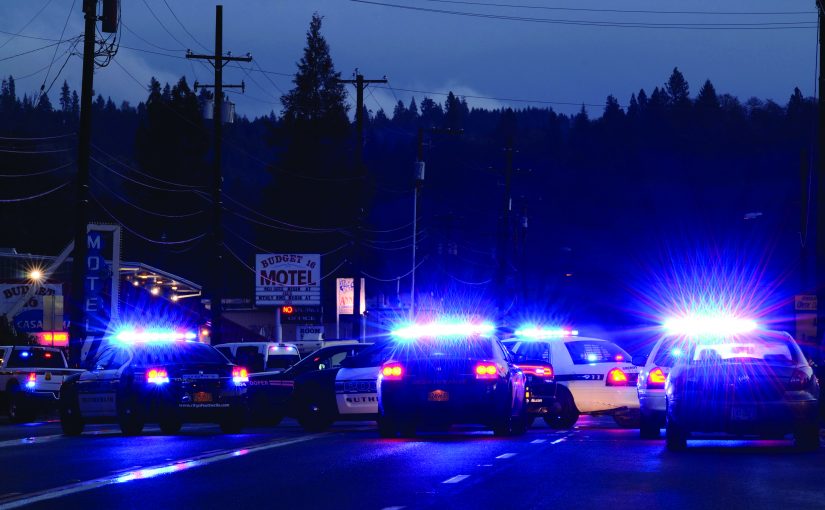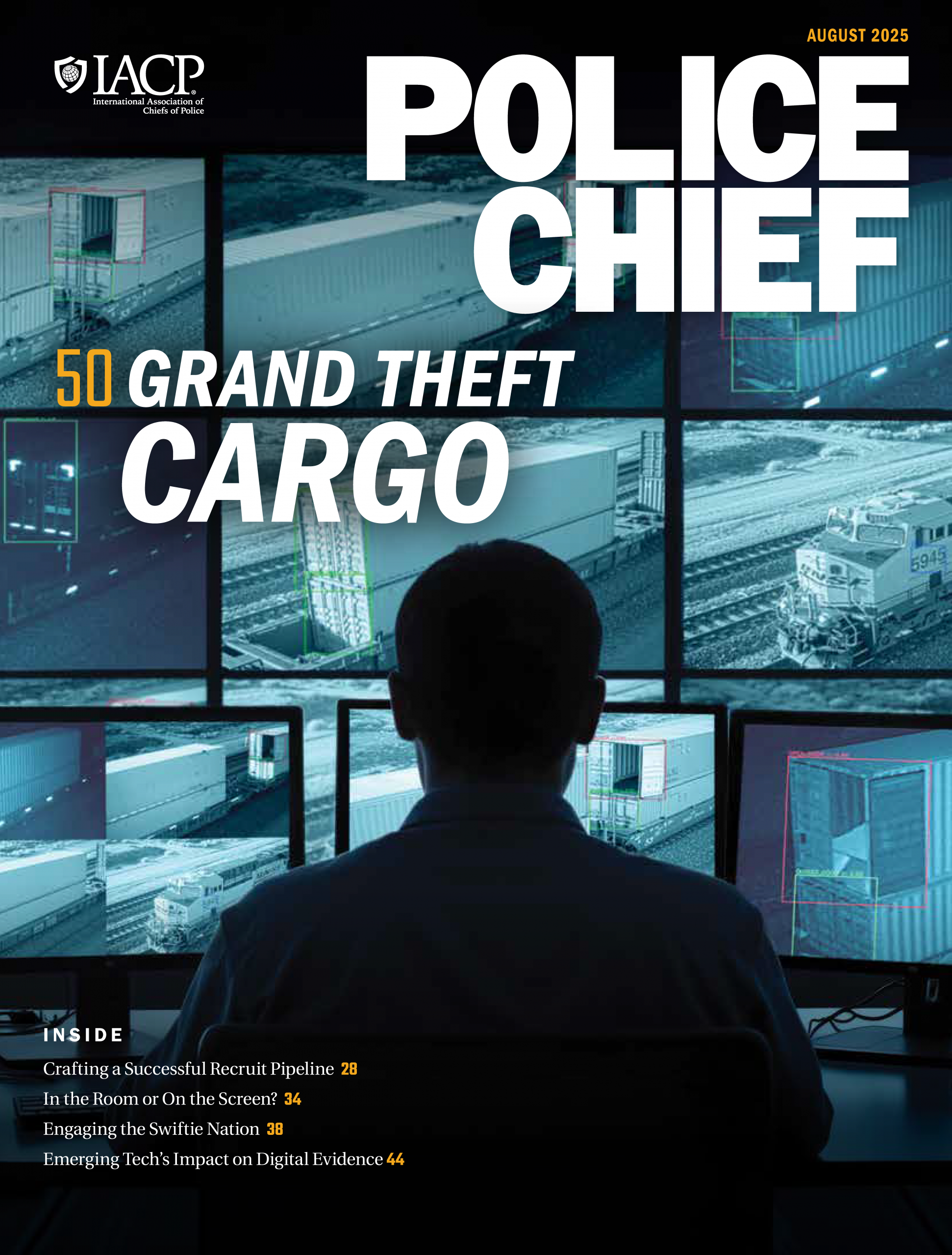Most law enforcement agencies spend a great deal of time creating policies and procedures to ensure some level of control over every device officers utilize on patrol, except for one—the flashlight. Whether the light is weapons-mounted or handheld, 100 lumens or 5,000 lumens, halogen or multi-function LED, or has a “hotspot” or wide spill, there is little guidance or training for this ever-evolving tool. However, due to the advances in lights specifically marketed to law enforcement, there is an identifiable need to address this issue. The misunderstanding, misuse, and lack of training with lighting systems can and have had an effect on officer decision-making in use-of-force
encounters—decisions that can have civil and criminal implications.
Law enforcement rarely considers the science of human factors or the many “human” aspects affecting the confluence of the individual and devices in the work environment. As the law enforcement industry searches for ways to mitigate error and enhance decision-making, it cannot afford to ignore the science behind human capabilities and limitations. Lighting systems have evolved, are multifunctional, and can produce negative outcomes based on individual and environmental factors.
Human Vision
No policy, procedure, tactic, or training should be created or manipulated without the appropriate evidence and follow-up testing and evaluation. The information provided is the evidence behind the need for further scrutiny; the responsibility for testing and evaluation is the agency’s. The initial presentation of this evidence in regard to lighting systems begins with human vision. Perfect vision is often identified as being “20/20,” or what a normal person sees at 20 feet. When vision is reduced to 20/40, it indicates the individual must be 20 feet away to see what a person with normal vision would see at 40 feet. A California POST compilation of vision studies states that vision at night, under street lamps, is reduced to 20/60, which means a subject must be at 20 feet to see what a normal person would see at 60 feet during the day.1 This may sound inconsequential on paper, but consider most law enforcement preemployment screening requires 20/40 uncorrected vision as a hiring condition. In context and based in science, an officer working a night shift under streetlamps or moonlight likely has less visual acuity than what is required to be considered for employment.
Preemployment vision requirements are evidence-based recommendations (in part) from studies determining the ability of officers to correctly identify objects held in subjects’ hands at a distance. The California POST compilation of vision studies demonstrates officers must have 20/40 vision at 15 yards or 20/63 vision at 7 yards in order to correctly identify handheld objects in low light with 100 percent accuracy.2 Within the same document, evidence indicates that vision can be reduced to 20/60 under streetlamps (at night) and 20/200 in near total darkness. These visual impairments in low light are also propagated in the aviation and military communities based on scientific study.

While the consideration of clinical visual acuity is important, other aspects of vision may have even greater influence. The biology of the human eye explains why visual acuity decreases during low light. Vision is the result of light reflecting from the surface of an object back to the retina (back wall) of the eye. The retina is layered with photoreceptors named rods and cones. The cones provide the best high-acuity color vision and are associated with daylight “photopic vision.” The cones are centralized in the macula and provide a small area of high acuity vision at about 3 degrees from center. This small area of high-acuity vision is moved both consciously and subconsciously to view the environment (visual saccades). The brain receives the visual information and constructs the perception of a seamless stream of high-definition vision. Most of us rarely notice the deficits in peripheral vision (10 degrees or more) unless our attention is overtly directed there while our eyes remain static.
A method of experiencing the small degree of high-acuity vision is to hold your thumb out at arms length and just in front of this text (1 inch away). Close one eye and focus your central vision on the thumbnail. Without moving your eye, attempt to read the narrative to the right and left of the thumbnail. You will find the words are blurry or unreadable. This represents the 3-degree foveal vision provided by the cones in the macula. This is why a glance at a cellphone, even held up in front of the windshield, may cause drivers to miss changes in the environment directly in front of them.

The rods are spread out to the left and right of the retina and are geared toward low light, monochromatic, and peripheral vision, while providing much less visual acuity. Moving from light to dark areas starts an adaptation process from cone-related photopic vision (daylight) to rod-related scotopic vision (darkness) while passing through a mixed (rod/cone) area of mesopic vision. The complete adaptation of the eye’s visual capabilities from daylight to low-light vision may take up to 45 minutes, which is important considering the work environment of patrol officers. More importantly, both short-term (1–2 seconds) and intermediate-term (minutes) adaptions can be problematic for law enforcement officers while operating in rapidly evolving situations that involve changing lighting. During these shorter-term transitions, the ability to see detail can be greatly diminished, and an officer could be essentially blinded in much the same way a driver is blinded by the headlamps of an oncoming vehicle. Most individuals have likely experienced the effects of this example and know that it takes a few moments to recover. In law enforcement applications, these few moments can be critical.
The most important point to consider under the umbrella of low-light vision is the concept of contrast sensitivity and the ability to see detail in low light. For instance, a dark object in front of a dark background can be difficult to identify even under daylight conditions due to the similarities in background and the lack of detail provided by reflected light. When low-light conditions exist, the detail found in similar situations (as the example above) will be increased or decreased based on the intensity of light, flashing lights, lighting location, the viewpoint of the officer, and movement. Contrast sensitivity, along with visual acuity and light adaptation can culminate to create a mistake in perception. Add to this the context of a rapidly evolving, tense, and uncertain environment where a weapon can be involved and the potential for a mistake-of-fact shooting is increased.3

Low-Light Mistake-of-Fact Shootings
Studies concerning low-light mistake-of-fact shootings are rare; however, the information provided by various reputable sources is sufficient to create an intriguing picture. The first source is the FBI’s Law Enforcement Officers Killed and Assaulted (LEOKA), which provides data on officers who are killed or assaulted in the line of duty. LEOKA data show 238 of the 505 officers feloniously killed and 251 of the 533 officers assaulted (2005–2014) were attacked during hours of low light (8 p.m.–6 a.m.).4
In addition to LEOKA data, and important for intuitive correlation, a few agencies have included low-light information in their shooting statistics. A 1996 statistical analysis from the New York Police Department found that 77 percent of their officer-involved shootings occurred in “diminished lighting.”5 Miami, Florida, Police Department also provided data showing that 62 percent of their outdoor shootings (1988–1994) occurred in “other than ‘daytime’ conditions.”6
The Las Vegas Metropolitan Police Department’s Office of Internal Oversight published a Deadly Force Statistical Analysis for the years 2009 to 2013. Within the analysis, the office reported 14 mistake-of-fact shootings, of which 57 percent were during low-light hours (6 p.m.–6 a.m.).7 The Michigan Commission on Law Enforcement Standards conducted research on their state’s officer-involved shootings and found one of the most common problems identified that circumscribed mistake-of-fact shootings was based on inaccurate threat assessments under low light.8 A study conducted on low-light shootings sampled mistake-of-fact incidents from Los Angeles County, California, between 1998 and 2002, and the author found mistake-of-fact shootings were based in part on, “Misidentification of the threat level due to impaired visual ‘contrast sensitivity’ in low levels of ambient light.”9
While there are few studies of this type, law enforcement is aware that mistake-of-fact shootings cost agencies millions in civil liability and can result in criminal charges and loss of employment for the officer involved. The evidence suggests that low-light mistake-of-fact shootings should be something of great interest to law enforcement, and a need to address this area with policy, procedure, tactics, and training exists.
The Problem & New Evidence
It has been repeated time and again that law enforcement does not (generally) train appropriately for low-light encounters. Attorney and police practices expert Jack Ryan has written extensively regarding the failure to adequately train officers in shoot–don’t shoot decision-making, including in low-light situations.10 Most importantly, the decision-making training needs to reflect the conditions the officer is likely to face. Mr. Ryan discusses the court case Popow v. City of Margate in which the court noted the involved officer had no low-light shooting training, citing this as potentially “grossly inadequate.”11 Ultimately, Mr. Ryan states that qualification courses and combat marksmanship are insufficient and decision-making training, inclusive of low-light training, must be conducted on a regular basis. Compare Mr. Ryan’s statement to a recent national online survey (318 respondents) conducted by Blake Consulting:
- Of the surveyed officers, 95 percent stated their agency had no policy or recommendation on lumen levels for flashlights or weapon-mounted lights.
- Also, 13 percent had no low-light training, while 47 percent had low-light range qualification training only once a year.
- Only 1 percent had low-light training, both indoors and outdoors, multiple times a year.
- Of the surveyed officers, 60 percent did not receive low-light decision-making (shoot–don’t shoot) training.
- Finally, 70 percent said they had no training on night vision.
What the Low-Light Subject Matter Experts Say
Ken Good, former Navy SEAL and highly respected low-light tactical trainer, stated that environmental situations will dictate the necessary intensity of the lighting systems used. He recommends a multifunction LED handheld light be used in conjunction with a weapons-mounted light in order to adjust as necessary. In regard to mistake-of-fact shootings in low light, Mr. Good suggests that training in stress-based decision-making scenarios is most important in mitigating error.12
Aaron Cowan, a federal law enforcement officer and accomplished low-light tactical trainer, recommends the highest level lumen lighting possible. Mr. Cowan has seen unskilled and untrained students blind themselves during interior searches and states that training is essential in mitigating this effect.13
Gordon Gray, a 32-year veteran of law enforcement with 21 years of SWAT experience and the owner of a private firearms training business, agrees with others in recommending the highest level lumen light possible. He also agrees that officers can blind themselves if untrained and recommends that officers are trained sufficiently in using both weapon-mounted and handheld lighting systems in a tactical environment.14
Summary & Recommendations
A law enforcement officer’s use of a firearm when confronted with the reasonable perception of a deadly force threat is now under more scrutiny than ever before. Law enforcement officers know these incidents occur more often in low light, and they know human vision experiences deficits in low light—the confluence of which provides a foundation to review policy, procedure, tactics, and training in regard to the use of flashlights and weapon-mounted lights. Suggestions for agencies follow:
- Law enforcement agencies should train officers in pertinent aspects of night vision.
- Law enforcement officers and trainers should make testing and training officers in using lighting systems in various environments (indoor, outdoor, and transitions) a priority.
- Low-light training should be conducted indoors and outdoors with shoot–don’t shoot decision-making a priority.
- Agency executives should provide evidence-based guidance on lighting systems from human factors science, as well as testing and evaluation completed by subject matter experts.
- Use-of-force and officer-involved shooting investigators should be aware of lighting and night vision issues and to include them (forensically) during investigations. ♦
| David Blake, MSc, FSA, CCI, is a police practices and use-of-force expert witness and a contract instructor with the California Training Institute facilitating their CA-POST certified courses entitled Force Encounters Analysis, and Human Factors, Threat, and Error Management. He is a former adjunct professor of criminal justice and a current police academy and force options simulator instructor. He is a published author in several periodicals and journals, including a quarterly column entitled “The Science of Training.” He holds a bachelor of science in criminal justice management and a master of science in psychology. He is a certified criminal investigator with the American College of Forensic Examiners Institute and a force science certified analyst with the Force Science Institute. |
Notes:
1 Jeffrey Hovis et al., “Vision Guidelines,” in Medical Screening Manual for California Law Enforcement, eds. R. Leonard Goldberg, Shelley Weiss Spilberg, and Stephen G. Weyers (California Commission on Peace Officer Standards and Training, 2015), http://lib.post.ca.gov/Publications/Vision.pdf.
2 Ibid.
3 Marc Green, “Is It a Gun? Or Is It a Wallet?” http://www.visualexpert.com/Resources/policeshooting.html.
4 Federal Bureau of Investigation, Law Enforcement Officers Killed and Assaulted (LEOKA), 2014, table 20, Law Enforcement Officers Feloniously Killed: Time of Incident by Type of Assignment, 2005–2014; LEOKA 2014 table 99, Law Enforcement Officers Assaulted and Injured with Firearms or Knives/Other Cutting Instruments: Time of Incident by Type of Assignment, 2010–2014.
5 Thomas J. Aveni, “Officer-Involved Shootings: What We Didn’t Know Has Hurt Us,” Law & Order (August 2003), http://www.theppsc.org/Staff_Views/Aveni/OIS.pdf.
6 Ibid.
7 Office of Internal Oversight, Critical Incident Review Team, Deadly Force Statistical Analysis 2009-2013: Las Vegas Metropolitan Police Department, July 1, 2014, http://www.lvmpd.com/Portals/0/OIO/Deadly_Force_Statistical_Analysis_2009-2013.pdf.
8 Michigan Commission on Law Enforcement Standards, “In-Service Firearm Standard to be Pilot Tested Across State: Prototype to Emphasize Officer Safety and Survival,” MCOLES newsletter, April 2007, https://www.michigan.gov/documents/mcoles/MCOLES_Newsletter_April_2007_193299_7.pdf.
9 Aveni, “Officer-Involved Shootings.”
10 Ibid.; Jack Ryan, “Agency and Personal Liability in Failure to Provide Shooting Training,” Public Agency Training Council, e-newsletter, May 7, 2009, https://www.patc.com/enewsletter/legal-answers/1-may09.shtml.
11 Popow v. City of Margate, 476 F. Supp. 1237 (N.J. 1979).
12 Ken Good (former Navy SEAL; founder, Progressive Combat Solutions), email, June 16, 2016.
13 Aaron Cowan (patrol officer and trainer, U.S. Department of Defense Police; instructor, Sage Dynamics), email, June 14, 2016.
14 Gordon Gray (former patrol officer/SWAT officer, Stockon Police Department; owner, Gray Ops Firearms Specialty Training), email, June 10, 2016.



